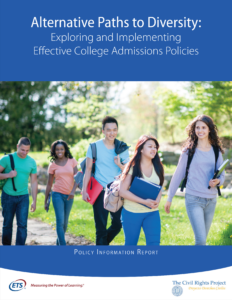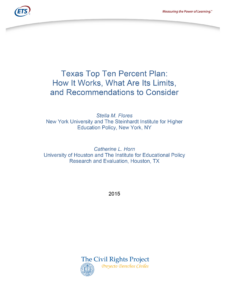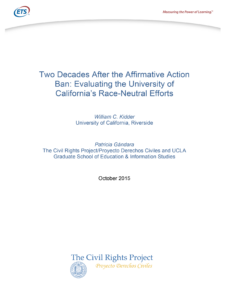Abstract
In this study, we examine the issues raised by the Supreme Court’s decision in the 2013 Fisher v. University of Texas at Austin case. The decision permitted affirmative action but required colleges challenged by students claiming discrimination to show that they could find no feasible way to achieve the needed diversity without considering race, among other factors, in the admission process. For selective colleges and universities across the country, the carefully considered study of the experiences of the University of California (UC) since Proposition 209 prohibited affirmative action can help inform what the Fisher Court described as “serious, good faith consideration of workable race-neutral alternatives.” Moreover the Grutter Court’s guidance included that “universities in other states can and should draw on the most promising aspects of these race-neutral alternatives as they develop.” This paper provides a case study of the efforts and outcomes of the race-neutral alternatives that were developed and implemented in the UC, the nation’s largest system of research universities, in the wake of the loss of affirmative action. Operating in an extremely diverse state, the UC has been very actively pursuing alternatives for nearly two decades and invested a great deal of its scarce funds in these efforts in spite of cutbacks in overall state funding. The study includes both campus-level enrollment outcomes, especially at the UC Berkeley and UC Los Angeles (UCLA) campuses where the impact of Proposition 209 was felt most acutely, and the UC system activities and outcomes as a whole.
The UC and the state government reacted almost immediately to the affirmative action ban, which had been strongly opposed by university leaders, with an array of race-neutral alternatives, including outreach, partnerships with high minority schools, academic preparation programs (some of which it invented), and targeted information and recruitment efforts. Later it implemented a percent plan and invested heavily in comprehensive review of vast numbers of applications. It modified admissions criteria and gave special attention to low-income students. The state also came to operate one of the most generous need-based financial aid programs in the country. The university has implemented all of the major race-blind programs that have been shown to have potential for increasing diversity, and private philanthropy has attempted to deal with the shortcomings of those efforts with race-targeted funding.
In spite of high investments of both human and financial resources in many areas, the UC has never recovered the same level of diversity that it had before the loss of affirmative action nearly 20 years ago—a level that at the time was widely considered to be inadequate to meet the needs of the state and its young people. It has never come close to a student body representing the state’s population. The university’s efforts over two decades have clearly fallen short, not only in undergraduate programs but in key professional schools, particularly at the most competitive UC campuses, which are consistently ranked among the world’s leading universities and that train leadership in many fields.
This brief and three others are the result of a collaboration between the Civil Rights Project and the Educational Testing Service, Strengthening Campus Diversity: How Do We Address This Important Issue? The four issue briefs discuss how college campuses can attempt to maintain and expand diversity within a legal framework.
The other three briefs are:
- “Can Socioeconomic Status Substitute for Race in Affirmative Action College Admissions Policies? Evidence From a Simulation Model,” by Sean F. Reardon (Stanford University), Rachel Baker (UC Riverside), Matt Kasman (Brookings Institution), Daniel Klasik (George Washington University), and Joseph B. Townsend (Stanford University).
- “Texas Top Ten Percent Plan: How It Works, What Are Its Limits, and Recommendations to Consider,” by Stella M. Flores (New York University) and Catherine L. Horn (University of Houston).
- “The Promise and Peril for Universities Using Correlates of Race in Admissions in Response to the Grutter and Fisher Decisions,” by Mark Long (University of Washington).
In compliance with the UC Open Access Policy, this report has been made available on eScholarship:





